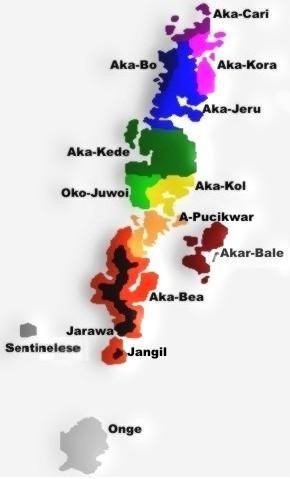Bo people (Andaman)

The Bo were one of the ten indigenous tribes of the Great Andamanese people, originally living on the western coast of North Andaman Island in the Indian Ocean.
The tribe spoke a distinctive Bo language, closely related to the other Great Andamanese languages. The native name for the language was Aka-Bo (Aka- being a prefix for "tongue"); and this name is often used for the tribe itself. They were mostly forest-dwellers (eremtaga) with a smaller number of shore-dwellers (aryoto).[1] They are a designated Scheduled Tribe.[2]
There are still a handful of people who identify themselves as members of the tribe living on a reservation on Strait Island, but none can speak the original language.[3]
History[]
The original size of the Bo tribe, by 1858, has been estimated at 200 individuals.[4] However, they were discovered by the British only later, in the work leading to the 1901 census.[4] Like other Andamanese peoples, the Bo were decimated during colonial and post-colonial times, by diseases, alcohol, colonial warfare and loss of territory. The census of 1901 recorded only 48 individuals.[5] Census takers were told that an epidemic had come from the neighboring Kari and Kora tribes, and the Bo had resorted to killing all of their own who showed symptoms.[4] Their number was up to 62 in 1911, but then decreased to 16 in 1921 and only 6 in 1931.[4]
In 1949, any remaining Bo were relocated, with all other surviving Great Andamanese, to a reservation on Bluff island. In 1969 they were moved again to a reservation on Strait Island.[6] By 1980 only three out of the 23 surviving Great Andamanese claimed to belong to the Bo tribe.[1] By 1994 their numbers had grown to 15 (out of 40).[5]
However, tribal identities became largely symbolic in the wake of the relocations. By 2006 the cultural and linguistic identity of the tribe had all but disappeared, due to intermarriage and other factors. The last speaker of the Bo language, a woman named Boa Senior, died at age 85 in late January 2010.[7][8]
References[]
- ^ a b George Weber (~2009), The Tribes. Chapter 8 in The Andamanese Archived 5 August 2012 at the Wayback Machine. Accessed on 2012-07-12.
- ^ "List of notified Scheduled Tribes" (PDF). Census India. p. 27. Archived from the original (PDF) on 7 November 2013. Retrieved 15 December 2013.
- ^ Anvita Abbi (2006), Endangered Languages of the Andaman Islands. Lincom Europa.
- ^ a b c d George Weber (~2009), Numbers Archived 31 May 2012 at the Wayback Machine. Chapter 7 in The Andamanese Archived 5 August 2012 at the Wayback Machine. Accessed on 2012-07-12.
- ^ a b A. N. Sharma (2003), Tribal Development in the Andaman Islands, page 62. Sarup & Sons, New Delhi.
- ^ Rann Singh Mann (2005), Andaman and Nicobar Tribes Restudied: Encounters and Concerns, page 149. Mittal Publications. ISBN 81-8324-010-0
- ^ (2010) Language lost as last member of Andaman tribe dies. The Daily Telegraph, London, 5 February 2010. Accessed on 2010-02-22.
- ^ (2011) "Lives Remembered". The Daily Telegraph, London, 10 February 2010. Accessed on 2010-02-22. Also on web.archive.org
External links[]
- http://english.aljazeera.net/news/asia/2010/02/20102543519461807.html
- http://www.timesonline.co.uk/tol/news/world/asia/article7015540.ece
- http://www.survivalinternational.org/films/last-of-the-bo-tribe
- https://web.archive.org/web/20100209004900/http://www.rnw.nl/english/article/bo-tribe-extinct
- https://web.archive.org/web/20100209082426/http://www.aolnews.com/world/article/boa-sr-last-member-of-bo-tribe-on-andaman-islands-dies/19346945
- Ethnic groups in the Andaman and Nicobar Islands
- Scheduled Tribes of the Andaman and Nicobar Islands
- Extinct ethnic groups